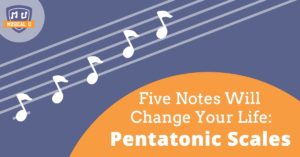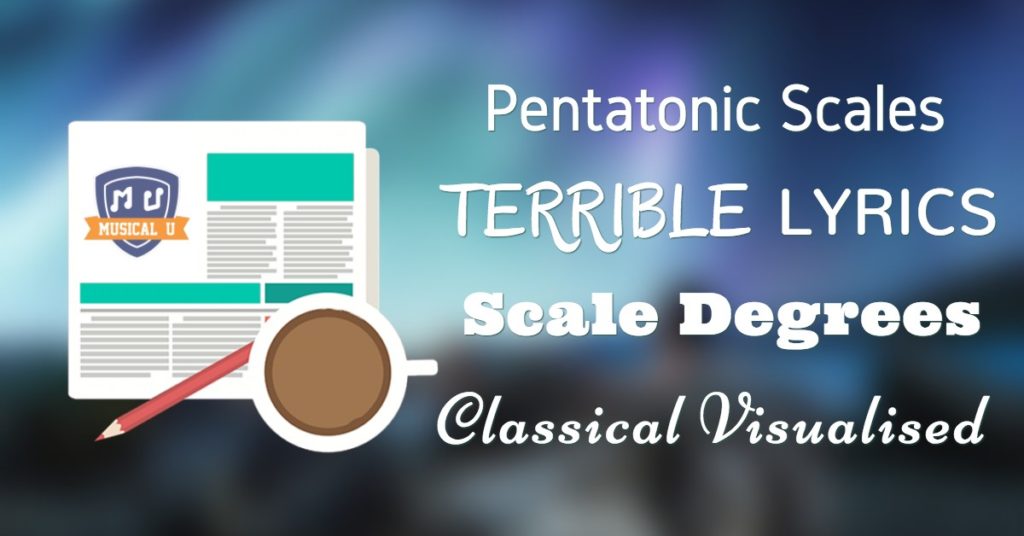You don’t need to study music history to know that things have changed. Music may have been with us since the earliest cave-people bashed bones together and danced around a fire grunting, but (for the most part!) it looks and sounds pretty different today. The development of musical styles over thousands of years has produced both elegant simplicity and overwhelming complexity.
This week we took an in-depth look at one of the oldest and most universal scales: the major pentatonic. Our Resident Pros tackled the question of “How can you learn to actually recognise the notes of a scale by ear?” to help you decipher the flurry of notes you hear in a piece of music. We had the chance to interview the designer of some incredible diagrams that help concert-goers make sense of the sometimes-intimidating complexity of classical music. Oh – and just in case it was all feeling a bit too sophisticated we also explored the wonderful world of so-bad-it’s-good-again song lyrics.
Before we dive in, a quick shout out of thanks to the Guitar and Music Institute for inviting Musical U’s Director Christopher Sutton to be a guest on their excellent podcast this week! You can listen in on their conversation and learn more about the great work that GMI do right here.
Pentatonic roots
 Did you know that there’s a scale more useful and versatile than the regular major scale – and it’s simpler to learn and use too? The major pentatonic scale was found used in instruments that are tens of thousands of years old and even today it’s remarkably useful across a broad range of musical situations and styles. Learn everything you need to know in Five Notes Will Change Your Life: Pentatonic Scales.
Did you know that there’s a scale more useful and versatile than the regular major scale – and it’s simpler to learn and use too? The major pentatonic scale was found used in instruments that are tens of thousands of years old and even today it’s remarkably useful across a broad range of musical situations and styles. Learn everything you need to know in Five Notes Will Change Your Life: Pentatonic Scales.
What are the major differences between the pentatonic and full diatonic scales? And how will that translate onto your instrument? For further instruction, and some great tips on moving back and forth between these two scales, Six String Country has this tutorial:
When learning pentatonic scales, the guitar player can greatly benefit by using the CAGED system to move around the fretboard. Wait… the what system? To learn more about the CAGED system and how it can benefit your playing, Guitar Lessons has this helpful video. If you’re not a guitar player, can you find similar patterns on your instrument?
Think the pentatonic scale is only for guitar and piano players? Think again! Bass players will really get into this lesson on using hammer-ons and pull-offs with pentatonic patterns from No Treble.
It seems like every week you hear about a new scale that a musician needs to learn to be proficient on their instrument… With all of these scales, how are you supposed to go about learning yet another one? Julian Bradley at The Musical Ear provides some great tips on how to separate scales into groups to get a better understanding of how they work, which will help you to remember and use them in your playing.
It’s all a matter of degree
 In our Instrument Packs this month our Resident Pros for guitar, bass, piano and singing revealed practical ways you can learn to recognise the notes of a scale by ear when you hear them in real music. As always, each instrument has its own quirks and techniques that can be used to help you learn these skills in a fast and useful way. Learn all about Scale Degree Recognition in our Resource Pack Preview.
In our Instrument Packs this month our Resident Pros for guitar, bass, piano and singing revealed practical ways you can learn to recognise the notes of a scale by ear when you hear them in real music. As always, each instrument has its own quirks and techniques that can be used to help you learn these skills in a fast and useful way. Learn all about Scale Degree Recognition in our Resource Pack Preview.
Guilty pleasures
“Baby, Baby, Baby”…
“Ring-ding-ding-ding-dingeringeding!”…
“Pop art pistol chasin’”…
“Oppa Gangnam Style!”
 Writing great lyrics is an art. Writing terrible lyrics is… all too common! When lyrics get worse and worse sometimes they come out the other side and are somehow kind of good! Or at least, they seem to work. Discover The Wonderful Phenomenon of Terrible Lyrics!
Writing great lyrics is an art. Writing terrible lyrics is… all too common! When lyrics get worse and worse sometimes they come out the other side and are somehow kind of good! Or at least, they seem to work. Discover The Wonderful Phenomenon of Terrible Lyrics!
As songwriters, what is the best way to make sure that the lyrics you write do actually fit with the overall theme of your song? Many songwriters write the melodies first, then work to fit in the lyrics around the melodic elements of their song. Here are five tips on how to match lyrics to your vocal melodies from the Hack Music Theory show:
If the lyrical content in many of these songs is so bad, why were they such big hits? How can you really explain the viral nature of a song like “Gangnam Style” by Psy? Simply, there were so many other elements of the song that made it incredibly compelling for the listener, and they couldn’t help but sing or dance along. While there are many “how-to” guides on writing a hit song throughout the internet, this 3-step process from Music Marketing Guy is very easy to implement and a great way to get started. SongTown has a helpful article sharing the 6 keys to writing compelling songs.
Want to know more about the process that hit songwriters go through when they are writing songs? Songwriter Ross Golan talks about songwriting and his new podcast with some of the best in the industry in this interview with BMI: “Nobody Writes A Hit Song By Accident”.
Since we talked about terrible lyrics quite a bit in this article, what about some amazing lyrics that influenced millions of people? Musical U has written before about the phenomenon that is “Hello” by Adele. For a great explanation of these lyrics, check out this podcast episode by the Pop Song Professor: “Hello, Adele! What Are You Sorry For?”
Can you visualise a symphony?
 To the outsider, classical music can seem like a difficult genre to break into. There is such tradition and structure and apparent complexity to classical music compared to the latest Bieber hit. For years, programme notes at concerts have tried to explain what’s happening in the music, to help the audience unlock its riches by ear. Now an innovative designer at the Toronto Symphony Orchestra has come up with a way to let you see what you should be listening for. Experience the power of Visualizing the Symphony, with Hannah Chan-Hartley.
To the outsider, classical music can seem like a difficult genre to break into. There is such tradition and structure and apparent complexity to classical music compared to the latest Bieber hit. For years, programme notes at concerts have tried to explain what’s happening in the music, to help the audience unlock its riches by ear. Now an innovative designer at the Toronto Symphony Orchestra has come up with a way to let you see what you should be listening for. Experience the power of Visualizing the Symphony, with Hannah Chan-Hartley.
These new Listening Guides have been a great way to engage with the audience at the Toronto Symphony Orchestra in a new, dynamic way. In fact, even seasoned, professional musicians can take a great deal from these guides and enjoy the music at an even deeper level. Where else could listening guides be effectively employed… perhaps by music teachers? Effective Music Teaching has this guide on guiding classroom discussions through their method of active listening.
Music and visual art have always been intertwined, and complementary of each other. Great pieces of art have inspired music, and music has inspired great pieces of art. What happens when the two are combined in one stunning display? Read about how Britt Conley and Virginia Bronze combined their efforts in one amazing concert.
With modern computing technology, visualizations of musical masterpieces are easier to create automatically and can greatly add to the listener’s experience. The Music Animation Machine, created by Stephen Malinowski, creates brilliant displays that are sure to captivate your imagination. Here is “Night on Bald Mountain” by Mussorgsky/Rimsky-Korsakov:
Music can be as simple or as complex as you want it to be. That goes for creating music yourself and also how you approach the music you hear or play. Hopefully these new articles, tutorials, and interviews inspire you to advance your own musical abilities and find new ways to simplify things which previously seemed complex.
With a nod to our article on great/terrible lyrics we couldn’t leave you today in any other way than with the immortal words of Ms. Rebecca Black: “It’s Friday, Friday. Gotta get down on Friday. Everybody’s lookin’ forward to the weekend, weekend.”








